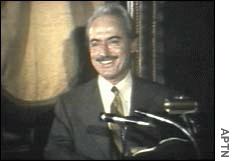|
Owners can't ignore union
|
 |
November 9, 2001: 12:04 p.m. ET
Ex-union boss Marvin Miller says players will be able to block contraction.
A twice-weekly column by Staff Writer Chris Isidore
|
NEW YORK (CNNmoney) - One of the most influential figures in modern professional sports says he fully expects baseball to field 30 teams next year, and not go ahead with plans announced this week to drop two teams.
"I say it as an illustration of again how foolishly the owners seem to act," said Marvin Miller about the contraction plans announced by major league owners this week. "The notion that you can just ignore the union is foolish, and becomes more foolish each time they do it."
Love him or hate him, Miller is someone who is tough to ignore when talking about labor relations in baseball in general and U.S. sports as a whole.
The former executive director of the Major League Baseball Players Association, he was the one who started a string of eight straight negotiating wins for the union during 30 years that created free agency, salary arbitration and transformed the nature of professional sports.
Before Miller, owners could and did ignore players' wishes. They would refuse to negotiate with players' agents, or award multiyear contracts. Players had no bargaining leverage, no matter their performance on the field. The average salary before the first players' strike in 1972 was $31,532. Today it is close to $2 million.

|
|
|
Why is this man smiling? Because former players' union boss Marvin Miller, shown here in a 1973 photo, says that baseball can't move ahead with its contraction plans without the union's OK. | |
The owners have apparently come up with a new theory of how to deal with the players union - if you can't beat them, pretend they're not there. They tried to hand the union their first defeat in the lifetime of most players by simply announcing the unilateral action.
Commissioner Bud Selig admitted that management would have to negotiate with the union how the players with the two yet-unnamed franchises will be dispersed, but not about whether contraction would take place.
Contraction seen as idle threat
The union vowed to challenge the decision, but has otherwise been limited in its comments. But Miller, who retired from the union in 1982, told me this week that he doubts the union or most players are even taking the threat of contraction seriously.
"I dare say if you take a survey of the players and people at union level, if this is for real or if the owners are just trying to push players around again, the latter is the prevailing view," he told me this week.
And he says that the union once again has strong case law on its side in fighting any move to disband the teams. Miller, who worked for the United Steelworkers union before joining the Players Association, said shuttering two teams is wholly different in the eyes of the law than closing two money-losing steel mills or auto plants or any other union-represented facility.
"Normally the union represented the workers losing their jobs. Here the union represents everyone, including the places where the players would be dispersed. That's a different situation," he said. "You cannot view the case law on this question by looking at other industries. A U.S. Steel plant is not part of a league, not intertwined, legally anyway, with other companies. Obviously a baseball team, everything it does it can only do in conjunction with the others."
And the union's legal situation became stronger when the league's antitrust immunity in regards to labor relations was abolished as part of the union's last contract settlement, Miller said.
"The union, if it goes the court route, is not just arguing a violation of labor laws for failure to negotiate, but a violation of the antitrust law," he said.
A ploy for bargaining leverage?
Miller says that he believes the contraction move is as much about trying to gain leverage with different cities and state governments to build new stadiums as it is an attempt to gain the upper hand in negotiations with the Players Association.
"It's not just a ploy dealing with players, but with cities and other authorities that make decisions about financing stadiums," he said. "The reason you get suspicious: They haven't even named the teams. If they named the teams, what they did could be seen as bargaining chips for two authorities. It's even better as a bargaining chip if you don't name the teams."
But Miller said he doesn't believe the union would agree, or needs to agree, to contraction. He said overall league revenues are at record levels and still growing, and that the results of the past season point to the fact that a number of lower revenue teams can be competitive in the current environment. The Minnesota Twins, one of the franchises being discussed for possible contraction, spent much of the 2001 season in first place.
There have been some suggestions that owners would try to win union approval of contraction by adding two players to each remaining team, leading to a slight increase in major league jobs. But Miller said that would be a bad move for the union, beyond the fact that the utility player positions being added would be far lower paid than the starting positions on even the weakest teams.
Click for CNNSI's baseball coverage
"You're not just talking about 2 teams and 50 jobs. You're talking about establishing a precedent that the owners can eliminate jobs. That would be very troubling for players," said Miller.
Love him or hate him, those who ignored or bet against Miller's positions for the last 30 years were the ones disappointed at the end of the day.
Fans who are opposed to contraction, and there are far more of them than owners and many sports writers seem to realize, therefore have strong reason to hope this time around. 
Click here to send mail to Chris Isidore
|
|
|
|
|
|

|

